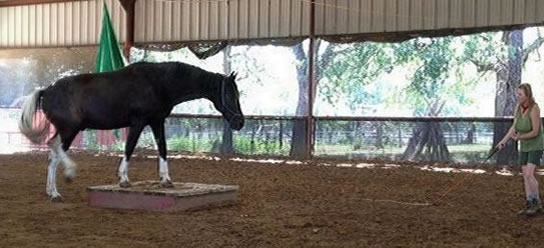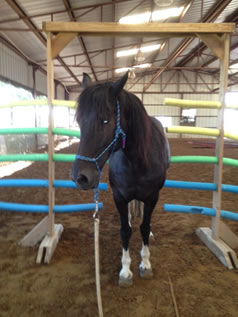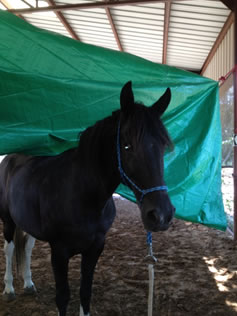The hardest rule of Equine Agility: No Contact!
HomeThe Seven Savvy Sisters of North Texas recently planned an Equine Agility play day with a novice and an open class. Each class has a different run of obstacles. A path or run through the obstacles was planned and marked with numbered cones. Scoring is based on the completion of the obstacles in the specific order defined for the run. Each class has a time limit for the obstacle run. Time limits are also different for online and liberty. In order to determine the time limits for each class, we used our horses for online and liberty trial runs.

Rocky Mounting the Pedestal at Liberty
This was my first exposure to Equine Agility competitions. I re-learned a lot of lessons during this new activity with Rocky. Naturally, the major lesson is one I have learned many times and still need to fully appreciate as we move to more challenging activities:
You get what you practice!
Prior to the trial runs, Rocky and I played with the obstacles like we normally do at home. Upon reflection, I realize that we practiced the same old patterns without any consideration for the different rules of the Horse Agility events. I ask Rocky to do something and we have some dwell time where he usually gets rewarded with an ear scratch or a belly scratch. When we are ready to move on, I gently toss the savvy string over his neck as I bring my energy up to signal we are moving on. While we were practicing with the Equine Agility obstacles, I used the same techniques and patterns that we use at home.
After some practice time, the group was ready to time the trial runs. Before the trial runs, we sat down and reviewed the rules. I knew I was in trouble with one rule: No contact, including sticks and strings, is allowed with the horse at any time during the course, except the option of giving treats by hand. Contact of any type, which is not allowed, will accrue a deduction of 20 points, per contact.
Rocky expects lots of contact as positive reinforcement. How would he know he was doing the right thing without those little ear scratches? How would he know we were done and moving on without that gentle toss of the savvy string over his neck? Many of the obstacles are the standard training obstacles we have been using for years.
Jumping barrels and logs aren’t a problem for us. Weaving cones is also a pretty routine activity. Although, I do need to perfect my cone weaving communication skills from longer distances.
There was a noodle squeeze obstacle. During practice, I sent Rocky into the noodles and asked him to stand there while I scratched his ear. Then, I backed away and took his picture before asking him to walk the rest of the way through the squeeze. Rocky did this obstacle perfectly during all of the timed trial runs.

Rocky in the Noodle Squeeze
There were two tarp obstacles. The run for the Novice class had a walk across the ground tarp obstacle. The Open class tarp obstacle was a hanging tarp blowing in the breeze. During our practice session, I sent Rocky under the tarp and let him stand there while I took his picture and scratched his neck. Rocky did all of the tarp obstacles perfectly during the online and liberty timed trial runs.

Rocky Under the Hanging Tarp
We don’t have a teeter totter at home so we spent some time practicing with it before the timed trial runs. For example, I walked across the teeter totter with Rocky while holding onto his mane. Later, I asked him to walk onto the teeter totter and pause while I gave him positive feedback with a good belly scratch. Then, I took his picture before we finished walking across the teeter totter.

Rocky on the Teeter Totter
This approach worked in practice, but not very well during the timed trial runs where you cannot touch the horse. Rocky walked on the teeter totter, paused to look at me for his belly scratching positive feedback, and then walked off the side of the teeter totter when he didn’t get his normal positive reinforcement. During the timed runs, we lost all of the points for this obstacle.
There were two pedestals in the runs. In one run, the horse should stand on the big square pedestal for 5 seconds and the horse just walks across the small round pedestal. Rocky stood on the big pedestal for 5 seconds and then walked on according to the plan. We successfully did this both at liberty and online.
The problem was walking across the round pedestal. The round pedestal is really small. When we normally play with that pedestal, Rocky puts his front feet on the pedestal and I let him stand there for some dwell time while I scratch his belly or neck or ear. During the agility trial runs, he did exactly that! Rocky put his front feet on the round pedestal, looked at me for his positive feedback, and when he didn’t get it; he backed off of the pedestal and then got on again with his front feet. If only, I could have given him that little bit of positive reinforcement with a quick neck scratch. Rocky was just repeating a pattern as we have practiced it so many times!
Rocky and I had a lot of fun doing trial runs for the Equine Agility play day. I came away with some good ideas for more provocative ways to play with our obstacles at home. Communication skills are ever so important and I have some good ideas for working on my “no contact” communication with Rocky.